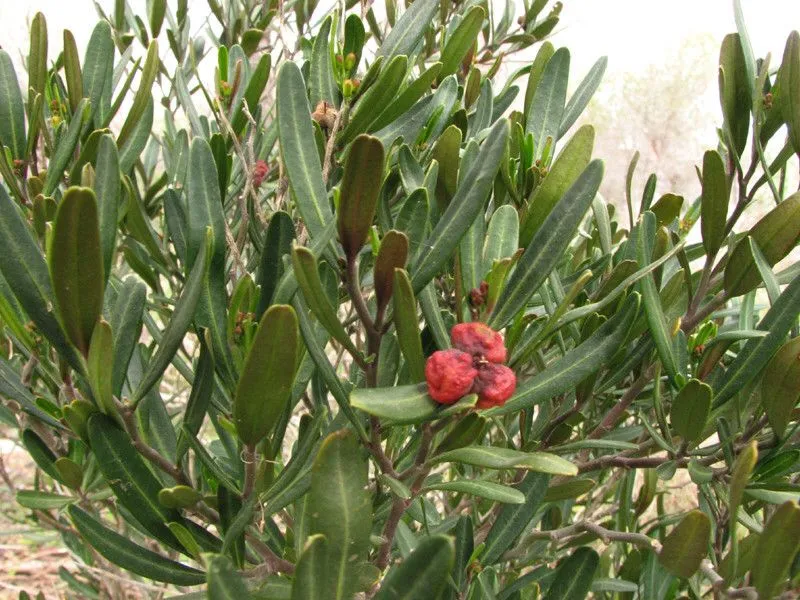
Author: L.
Bibliography: Sp. pl. 1:34. 1753
Year: 1753
Status: accepted
Rank: species
Genus: Cneorum
Vegetable: False
Observations: Spain to Italy
The Spurge Olive, scientifically designated as Cneorum tricoccon, is a remarkable plant known for its distinctive characteristics and its presence across the Mediterranean region, particularly from Spain to Italy. This plant belongs to the Rutaceae family, which includes various aromatic shrubs and trees known for their significant ecological and medicinal value.
First described by Carl Linnaeus in 1753 in his seminal work “Species Plantarum”, the Spurge Olive has garnered attention for its adaptability and resilience in diverse climates and soils often found in Mediterranean ecosystems. This region’s unique environment, characterized by hot, dry summers and mild, wet winters, provides an ideal habitat for Cneorum tricoccon to thrive.
Characterized by its glossy, evergreen leaves and small, yet potent, flowers, the Spurge Olive adds both visual appeal and ecological value to its surroundings. The plant typically blooms between spring and summer, producing yellowish-green flowers that, while not particularly showy, play an essential role in the habitat by supporting various pollinators. Following the flowering period, the plant bears small, red berries that can often be observed in clusters. These berries, while visually attractive, should not be consumed as they can be toxic.
The Spurge Olive’s foliage has a leathery texture that helps it retain moisture, making it well-suited to its native dry, rocky habitats. These hardy leaves also contribute to the plant’s overall durability, allowing it to withstand the challenging conditions often present in coastal and inland Mediterranean areas.
Ecologically, the Spurge Olive is important as it supports local biodiversity. The plant not only provides nectar and pollen for insects but also offers shelter and food for various bird species. Moreover, its ability to grow in poor soil conditions helps prevent soil erosion, contributing to the stability of its native landscapes.
In addition to its ecological benefits, the Spurge Olive has been studied for various traditional uses. Historically, certain components of Cneorum tricoccon have been utilized in folk medicine, although modern use is less common due to the potential toxicity of the plant. As with many plants within the Rutaceae family, the Spurge Olive contains compounds that can be irritating or harmful if mishandled.
In summary, Cneorum tricoccon, or the Spurge Olive, is a plant of noteworthy significance within the Mediterranean region. With its resilient nature and ecological importance, it continues to be a subject of interest for botanists and ecologists alike. While its traditional uses have waned due to safety concerns, the Spurge Olive remains an integral component of its native habitats, contributing to the beauty and environmental health of the Mediterranean landscape.
Deu: dreibeeriger zeiland
Swe: dvärgoliv
Eng: spurge olive
En: Spurge olive
Ca: Olivella
Nl: Spurge Olive
Fr: Camélée, Garoupe, Camélée à trois coques
De: Dreibeeriger Zeiland, Zeiland, Zwergölbaum
It: Timelea tricocca
Oc: Camelèa
Es: Olivilla, Olivilla común
Sv: Dvärgoliv
© copyright of the Board of Trustees of the Royal Botanic Gardens, Kew.
© copyright of the Board of Trustees of the Royal Botanic Gardens, Kew.
© copyright of the Board of Trustees of the Royal Botanic Gardens, Kew.
Taken Mar 11, 2022 by Miguel A. C. (cc-by-sa)
Taken Apr 17, 2022 by Sylvain Piry (cc-by-sa)
Taken Apr 17, 2022 by Sylvain Piry (cc-by-sa)
Taken Mar 11, 2022 by Miguel A. C. (cc-by-sa)
Taken May 8, 2018 by Leo Giardi (cc-by-sa)
Taken Oct 15, 2007 by Photoflora – Jean-Luc TASSET (©)
Taken Oct 15, 2014 by Photoflora – Jean-Luc TASSET (©)
Taken Jan 1, 1970 by Photoflora – L’Abbé COSTE (©)
Taken Sep 29, 2020 by Alain Bigou (cc-by-sa)
Taken Apr 17, 2022 by Sylvain Piry (cc-by-sa)
Taken Oct 10, 2016 by Tela Botanica − Annick LARBOUILLAT (cc-by-sa)
Taken Oct 10, 2016 by Tela Botanica − Annick LARBOUILLAT (cc-by-sa)
Taken Apr 5, 2021 by hely (cc-by-sa)
Taken Mar 11, 2022 by Miguel A. C. (cc-by-sa)
Taken Apr 17, 2022 by Sylvain Piry (cc-by-sa)
Taken Jul 3, 2015 by Tela Botanica − Liliane ROUBAUDI (cc-by-sa)
Taken Jul 3, 2015 by Tela Botanica − Liliane ROUBAUDI (cc-by-sa)
Taken Jun 29, 2020 by Steve LE BRIQUIR (cc-by-sa)
Taken Mar 11, 2022 by Miguel A. C. (cc-by-sa)
Taken Mar 16, 2017 by Matesanz Ángel (cc-by-sa)
Taken Dec 21, 2020 by Matt C (cc-by-sa)
Taken Jun 25, 2014 by Tela Botanica − Yoan MARTIN (cc-by-sa)
Taken Jun 25, 2014 by Tela Botanica − Yoan MARTIN (cc-by-sa)
Taken Aug 17, 2020 by david ridet (cc-by-sa)
Taken Apr 14, 2021 by Pierre Bonnet (cc-by-sa)
Growth habit>: Subshrub
Ph maximum: 7.5
Ph minimum: 7.0
Light: 8
Atmospheric humidity: 3
Bloom months: [‘apr’, ‘may’, ‘jun’]
Soil nutriments: 4
Family: Myrtaceae Author: (F.Muell.) K.D.Hill & L.A.S.Johnson Bibliography: Telopea 6: 402 (1995) Year: 1995 Status:…
Family: Rubiaceae Author: Pierre ex A.Froehner Bibliography: Notizbl. Bot. Gart. Berlin-Dahlem 1: 237 (1897) Year:…
Family: Sapindaceae Author: Koidz. Bibliography: J. Coll. Sci. Imp. Univ. Tokyo 32(1): 38 (1911) Year:…
Family: Asteraceae Author: A.Gray Bibliography: Pacif. Railr. Rep.: 107 (1857) Year: 1857 Status: accepted Rank:…
Family: Fabaceae Author: Medik. Bibliography: Vorles. Churpfälz. Phys.-Ökon. Ges. 2: 398 (1787) Year: 1787 Status:…
Family: Aspleniaceae Author: (Cav.) Alston Bibliography: Bull. Misc. Inform. Kew 1932: 309 (1932) Year: 1932…